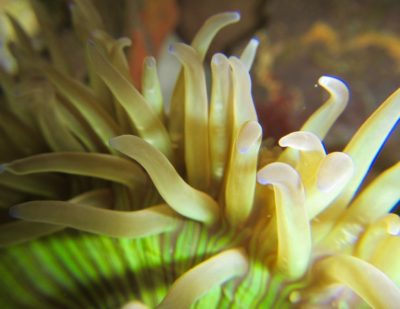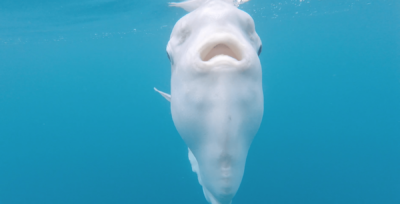
The Ocean Sunfish also known as the Mola Mola is perhaps the most strangely intriguing fish in ocean. Its appearance is more alien like than anything else though it isn’t from out of this world. The Mola Mola belongs to the class Osteicthyes that means bony fish. This differs from chondricthyes, which are fish that are made of cartilage like sharks or rays. The Mola Mola is particularly interesting fish. Though it is a bony fish that belongs in the order tetraodontiformes, which includes puffer fish and triggerfish, it lacks several structural features that are prominent on most of their fish cousins. The most glaring absence is the caudal fin (tail fin) and the presence of elongated dorsal and anal fins, which it uses to swim. They also lack a swim bladder, which is a special organ in bony fish that helps them maintain neutral buoyancy. Ocean Sunfish have buoyant skin to help them float which is very beneficial since Mola Mola have the potential to be large. They are the heaviest of all bony fish with some specimens recorded weighing over 5,000 pounds. To grow to such a size one would think that Mola would be carnivores with a high protein diet but instead they are pretty passive eaters that mainly eat jellies that they come across in the ocean. Some specimens have been found to have brittle stars and pieces of fish in their stomachs indicating that they may have a broader diet than previously thought.
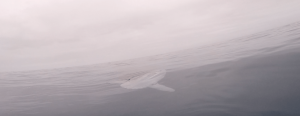
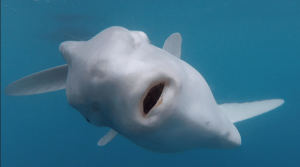 The Mola Mola is received the name Sunfish because their tendency to lay flat at the surface basking in sunlight. Historically they were thought to be planktonic and only go wherever the ocean currents would take them but Mola Mola are actually very strong swimmers that have the ability to dive to fairly deep depths. Sunfish have been observed swimming as deep as 600 meters. One theory that has yet to be proven is that Mola Mola bask at the surface to warm themselves up after extremely deep dives. They have also been known to swim beneath kelp rafts to let fish such as senoritas eat ecto-parasites that attach to their skin. On occasion they will even let birds like seagulls peck the parasites from their skin.
The Mola Mola is received the name Sunfish because their tendency to lay flat at the surface basking in sunlight. Historically they were thought to be planktonic and only go wherever the ocean currents would take them but Mola Mola are actually very strong swimmers that have the ability to dive to fairly deep depths. Sunfish have been observed swimming as deep as 600 meters. One theory that has yet to be proven is that Mola Mola bask at the surface to warm themselves up after extremely deep dives. They have also been known to swim beneath kelp rafts to let fish such as senoritas eat ecto-parasites that attach to their skin. On occasion they will even let birds like seagulls peck the parasites from their skin.
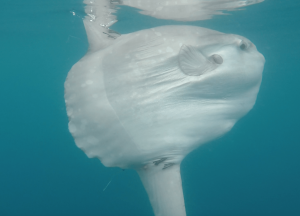
Mola Mola are found in every ocean except the arctic but breeding grounds or seasons have not been determined. Mola Mola do however lay over 300,000,000 million eggs per individual. The sunfish lays more eggs than every other know vertebrate.
Mola Mola have very few predators. Sharks, Orcas, and Sea Lions have been known to prey on Mola Mola but do not do it habitually. Humans do not regularly fish for Mola and there isn’t a market for them in most parts of the world. Humans are however the biggest threat to Mola due to bycatch from commercial fishing operations around the world.

